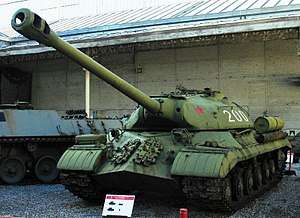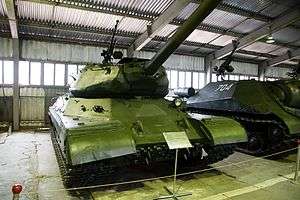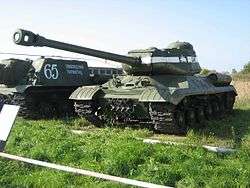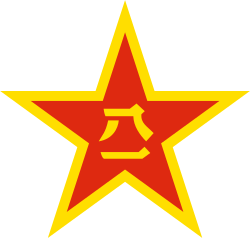IS tank family
The IS Tank was a series of heavy tanks developed as a successor to the KV-series by the Soviet Union during World War II. The IS acronym is the anglicized initialism of Joseph Stalin (Ио́сиф Ста́лин, Iosif Stalin). The heavy tanks were designed with thick armor to counter German 88 mm guns and carried a main gun capable of defeating Panzer IV tanks. They were mainly designed as breakthrough tanks, firing a heavy high-explosive shell that was useful against entrenchments and bunkers. The IS-2 went into service in April 1944 and was used as a spearhead by the Red Army in the final stage of the Battle of Berlin. The IS-3 served on the Chinese-Soviet border, the Soviet invasion of Hungary, the Prague Spring and on both sides of the Six-Day War. The series eventually culminated in the T-10 heavy tank.
| Iosif Stalin tank | |
|---|---|
 IS-2 model 1943 and IS-3 at the Great Patriotic War Museum, Minsk, Belarus | |
| Type | Heavy tank |
| Place of origin | Soviet Union |
| Service history | |
| Used by | Soviet Union, China, Cuba, Czechoslovakia, DPRK, Egypt, Poland |
| Wars | |
| Production history | |
| Designer | Zhozef Kotin Nikolay Dukhov |
| Designed |
|
| Manufacturer | Kirov Factory, UZTM |
| Unit cost | IS-2 Model 1944: 264,400 rubles[2] |
| Produced |
|
| No. built |
|
| Specifications (IS-2 Model 1944[4]) | |
| Mass | 46 tonnes (51 short tons; 45 long tons) |
| Length | 9.90 m (32 ft 6 in) |
| Width | 3.09 m (10 ft 2 in) |
| Height | 2.73 m (8 ft 11 in) |
| Crew | 4 |
| Armor | IS-2 Model 1944: Hull front: 100 mm at 60° angle Lower glacis: 100 mm at 30° angle Turret front: 100 mm (rounded) Mantlet: 155 mm (rounded) Hull side: 90–130 mm at 9-25° Turret side: 90 mm at 20° angle. |
Main armament | D-25T 122 mm gun (28 rounds) |
Secondary armament | 1×DShK, 3×DT (2,079 rounds) |
| Engine | 12-cyl. diesel model V-2 600 hp (450 kW) |
| Power/weight | 13 hp/tonne |
| Suspension | torsion bar |
| Fuel capacity | 820 l (180 imp gal; 220 US gal) |
Operational range | 240 km (150 mi) |
| Maximum speed | 37 km/h (23 mph) |
Design and production
Object 237 KV-85 IS-85/IS-1 and IS-2
The Object 237 prototype, a version of the cancelled KV-13, was accepted for production as the IS-85 heavy tank.[5] First deliveries were made in October 1943, and the tanks went immediately into service. Production ended in January 1944. Its designation was simplified to IS-1 after the introduction of the IS-122, later renamed as IS-2 for security purposes.
Object 703 IS-3
There are two tanks known as IS-3: Object 244 was an IS-2 rearmed with the long-barrelled 85 mm cannon (D-5T-85-BM) and developed by the Leningrad Kirov Plant (LKZ), which was never series-produced for service use.
The IS-3 known as Object 703 is a Soviet heavy tank developed in late 1944. Its semi-hemispherical cast turret (resembling an upturned soup bowl), became the hallmark of post-war Soviet tanks. Its pike nose design was also mirrored by other tanks of the IS tank family such as the IS-7 and T-10 tank. Too late to see combat in World War II, the IS-3 participated in the Berlin Victory Parade of 1945, on the Chinese-Soviet border, the Soviet invasion of Hungary, the Prague Spring and the Six-Day War.
Object 701 IS-4
There are two tanks known as IS-4: Object 245 and Object 701. Object 245 was an IS-2 rearmed with a long 100 mm D-10T cannon.
The IS-4 known as the Object 701 was a Soviet heavy tank that started development in 1943 and began production in 1946. Derived from the IS-2 and part of the IS tank family the IS-4 featured a longer hull and increased armor. With the IS-3 already in production, and when sluggish mobility and decreased need for tanks (particularly heavy tanks) became an issue, many were sent to the Russian Far East with some eventually becoming pillboxes along the Chinese border in the 1960s. Less than 250 were produced.
Object 705A IS-5
The IS-5, is merely one of the many designations given to what would ultimately become the T-10 tank.[6]
Object 252/253 IS-6
There existed two different IS-6s: the Object 253 was an attempt to develop a practical electrical transmission system for heavy tanks. Similar systems had been tested previously in France and the United States and had been used with limited success in the German Elefant/Ferdinand tank destroyer during World War II. The experimental transmission proved unreliable and was dangerously prone to overheating, and development was discontinued. The alternative Object 252 shared the same hull and turret as the Object 253, but used a different suspension with no return rollers, and a conventional mechanical transmission. The design was deemed to offer no significant advantages over the IS-2, just the reload time was less, and the IS-6 project was halted.
Object 260 IS-7
The IS-7 heavy tank design began in Leningrad in 1945 by Nikolai Fedorovich Shashmurin[7][8] and was developed in 1948.[9][10] Weighing 68 tonnes, thickly armoured and armed with a 130 mm S-70 long-barrelled gun, it was the largest and heaviest member of the IS family.[11]
Object 730 T-10
The IS-10[12] (also known as Objekt 730) was the final development of the KV and IS tank series. It was accepted into service in 1952 as the IS-10,[12] but due to the political climate in the wake of Stalin's death in 1953, it was renamed T-10.[13]
The biggest differences from its direct ancestor, the IS-3, were a longer hull, seven pairs of road wheels instead of six, a larger turret mounting a new gun with fume extractor, an improved diesel engine, and increased armour. General performance was similar, although the T-10 could carry more ammunition.
T-10s (like the earlier tanks they replaced) were deployed in independent tank regiments belonging to armies, and independent tank battalions belonging to divisions. These independent tank units could be attached to mechanized units, to support infantry operations and perform breakthroughs.
The T-10M is the final iteration of this type. It featured a longer gun barrel than previous models with 5-baffle muzzle brake and 14.5 mm machine gun. This was the last Soviet heavy tank to enter service. When the advanced T-64 MBT became available it replaced the T-10 in front line formations.
Comparisons
 IS-3
IS-3 IS-4
IS-4- An IS-7 tank during trials (1948)
- T-10M in the Museum of The History of Ukraine in World War II, Kiev.
| T-35 | T-100 | SMK | KV-1 M1940 |
KV-1 M1941 |
KV-1 M1942 |
KV-1S M1942 |
KV-85 M1943 |
IS-2 M1945 |
IS-3[15][16] M1945 | |
|---|---|---|---|---|---|---|---|---|---|---|
| Crew | 11 | 7 | 7 | 5 | 5 | 5 | 5 | 4 | 4 | 4 |
| Weight (tonnes) | 45 | 58 | 55 | 43 | 45 | 47 | 42.5 | 46 | 46 | 46.5 |
| Main armament | 76.2 mm M. 27/32 |
76.2 mm L-11 |
76.2 mm L-11 |
76.2 mm F-32 |
76.2 mm F-34 |
76.2 mm ZiS-5 |
76.2 mm ZiS-5 |
85 mm D-5T |
122 mm D-25T |
122 mm D-25T |
| Ammunition | 100 | – | – | 111 | 111 | 114 | 114 | 70 | 28 | 28 |
| Secondary armament | 2×45 mm 5×7.62 mm |
45 mm | 45 mm | 2×DT | 4×DT | 4×DT | 4×DT | 3×DT | 3×DT, DShK | 2×DT, DShK |
| Engine | 500 hp M-17M gasoline |
500 hp | 850 hp AM-34 |
600 hp V-2K diesel |
600 hp V-2 |
600 hp V-2 |
600 hp V-2 |
600 hp V-2 |
600 hp V-2 |
600 hp V-2-IS |
| Fuel (litres) | 910 | – | – | 600 | 600 | 600 | 975 | 975 | 820 | 520 + 270 |
| Road speed (km/h) | 30 | 35 | 36 | 35 | 35 | 28 | 45 | 40 | 37 | 37 |
| Road range (km) | 150 | – | 150 | 335 | 300 | 250 | 250 | 250 | 240 | 150 (225) |
| Armor (mm) | 11–30 | 20–70 | 20–60 | 25–75 | 30–90 | 20–130 | 30–82 | 30–160 | 30–160 | 20–220 |
Combat history
The IS-2 saw combat late in World War II in small numbers, notably against Tiger I, Tiger II tanks and Elefant tank destroyers. The IS-3 saw service on the Chinese-Soviet border, the Soviet invasion of Hungary, the Prague Spring and on both sides of the Six-Day War. However the mobility and firepower of medium-tanks and the evolution of the main battle tank rendered heavy tanks obsolete.
Variants
- KV-85
- A stopgap model built from a modified KV-1S hull mated to an Object 237(IS-1)'s turret and armed with the 85 mm D-5T.[17]
- IS-85 (IS-1)
- 1943 model armed with an 85 mm gun. When IS-2 production started, many were re-gunned with 122 mm guns before being issued.
- IS-100
- A prototype version armed with a 100 mm gun; it went into trials against the IS-122 which was armed with a 122 mm gun. Though the IS-100 was reported to have better anti-armor capabilities, the latter was chosen due to better all-around performance.
- IS-122 (IS-2 model 1943)
- 1943 model, armed with A-19 122 mm gun.
- IS-2 model 1944 (sometimes "IS-2m")
- 1944 improvement with D25-T 122 mm gun, with faster-loading drop breech and new fire control, and improved frontal hull armour using thinner armour with a more efficient shape.
- IS-2M
- 1950s modernization of IS-2 tanks.
- IS-3
- 1944 armor redesign, with new rounded turret, angular front hull casting, integrated stowage bins over the tracks. Internally similar to IS-2 model 1944, and produced concurrently. About 350 built during the war.
- IS-3M
- (1952) Modernized version of IS-3. Fitted with additional jettisonable external fuel tanks and improved hull welding.
- IS-4
- 1944 design, in competition against the IS-3. Longer hull and thicker armor than IS-2. About 250 were built, after the war.[18]
- IS-6
- Prototype with an experimental electrical transmission. Chassis tested further with a conventional transmission after failure of the experimental system, but not deemed a significant enough improvement over existing heavy tank designs to warrant mass production.[19]
- IS-7
- 1946 prototype, only three built. The IS-7 model 1948 variant had a weight of 68 metric tons and it was armed with the 130 mm S-70 naval cannon (7020 mm long barrel). The assisted loader can achieve up to 8 rounds per minute. Other equipment included stabilizers, infrared night scopes, and 8 machine guns. The hull armor was 150 mm placed at 50-52 degree angles. On the turret, the frontal thickness was 240–350 mm at an angle of 45-0 degrees. The IS-7 had a crew of five, with the driver in the hull, the commander and gunner in the front of the turret, with both loaders in the rear of the turret. A Slostin machine gun was to be installed as its AA armament.[11][20]
- IS-10
- [12] 1952 improvement with a longer hull, seven pairs of road wheels instead of six, a larger turret mounting a new gun with fume extractor, an improved diesel engine, and increased armor. Renamed T-10 as part of the Destalinization of the Soviet Union in the 1950s.
Operators
- People's Liberation Army: 60 IS-2s delivered in 1950–1951. Operated during the Korean War and in concrete bunkers along the Sino-Soviet border.
- Cuban Army: 41 IS-2Ms delivered in 1960.
- Czechoslovak Army: 8 IS-2/IS-2M in service between 1945-1960. Two IS-3 delivered in 1949 were used only for trials and military parades.
- NVA: 60 IS-2 delivered 1956. Operated until 1963.
- Egyptian Army: 100 IS-3M operated from 1956-1967, some in use in the Six-Day War 1967.
- Hungarian People's Army: 68 IS-2s in service between 1950-1956. After the crackdown of the Hungarian Revolution of 1956 all were returned to the Soviet Union.[22]
- IDF: Three IS-3M captured from Egypt in 1967. Reused as indirect fire artillery on the Sinai's Bar Lev line and as fixed turret bunkers fortifications along the Jordan Valley frontier.
- Korean People's Army: Small number of IS-2s; never deployed in combat in the Korean War.
- Polish Land Forces: Approximately 71 IS-2s used in combat between 1944-1945. 180 IS-2s survived as of 1955, and remained in service until the 1960s; some later were converted to armoured recovery vehicles. Two IS-3s were bought in 1946 for trials only.
- Romanian Land Forces: One IS-2 captured during clashes on the Romanian border between 28 May and 7 June 1944. The tank was subsequently exhibited in Bucharest.[23]
- South Ossetian Army: Operated some IS-2s, IS-3s and T-10s until 1995.
- Red Army: Heavy Breakthrough Tank from 1944-1945.
- Soviet Army: Phased out of service in the early-1970s.
- One IS-3, previously displayed on a pedestal in the village of Aleksandro-Kalynove near Kostiantynivka as a World War II memorial, used in combat by the Novorossiyan Armed Forces in the 2014 pro-Russian unrest in Ukraine.[24] Kostiantynivka was retaken by Ukrainian forces on 7 July 2014, along with the IS-3.[25][26]
Surviving vehicles
There are several surviving IS series tanks, with examples found at the following:
- IS-2
- Os. Górali [standing tank], Kraków, Poland
- Polish Army Museum, Warsaw, Poland
- Museum of Arms in Fort Winiary, Poznań, Poland
- Museum of Armoured Weapon in Training Center of Land Forces, Poznań, Poland (operational, see movie)
- Tank Museum of the People's Liberation Army, Beijing, China.
- Liberty Park, Overloon, The Netherlands.
- Museum of The History of Ukraine in World War II, Ukraine
- Kurzeme Fortress Museum, Zante, Latvia.
- Diorama Battle of Kursk, in Belgorod, Russia.
- The American Heritage Museum, Greater Boston, USA
- IS-2M
- Army Technical Museum, Lešany, Czech Republic[27] (previously in Prague as a Monument to Soviet tank crews)
- Imperial War Museum Duxford, England.
- Kubinka Tank Museum, Russia.
- Victory Park (Park Pobedy - Парк Победы), Ulyanovsk, Russia.
- Victory Park at Poklonnaya Gora, Moscow, Russia.
- IS-3
- IDF Armoured Corps Museum, Israel.
- Museum of Armoured Arms, Training Center of Land Forces, Poznań, Poland (still operational)
- Army Technical Museum, Lešany, Czech Republic (operational).[27]
- Polish Army Museum, Warsaw, Poland. (Fort Czerniaków branch of the Museum).
- National Armor and Cavalry Museum, Fort Benning, Georgia, United States.
- Victory Park in the northern part of Ulyanovsk, Russia.
- Ulyanovskoe SVU, Ulyanovsk, Russia
- Military Glory Museum, Gomel, Belarus.
- Diorama Battle of Kursk, in Belgorod, Russia.
- At least one IS-3 was used by the separatist government in Donbass before being captured by Ukrainian forces.
- IS-3M
- Egyptian National Military Museum, Cairo Citadel, Egypt.
- Military Vehicle Technology Foundation, California, United States.[28]
- Royal Museum of the Armed Forces and of Military History, Brussels, Belgium. (still operational)
- IS-4
- Kubinka Tank Museum, Russia.
- IS-7
- Kubinka Tank Museum, Russia.
Gallery
- IS-2
- IS-2M
 IS-2M at the Kubinka Tank Museum
IS-2M at the Kubinka Tank Museum The IS-3 at the Military Technical Museum Lešany
The IS-3 at the Military Technical Museum Lešany.jpg) IS-3 heavy tank at the Museum Polskiej Techniki Wojskowej in Warsaw.
IS-3 heavy tank at the Museum Polskiej Techniki Wojskowej in Warsaw. Former Egyptian Army IS-3M
Former Egyptian Army IS-3M
See also
- KV-1 heavy tank
- T-10 heavy tank
- ISU-152 assault gun
- ISU-122 assault gun
- List of Soviet tanks
- March of the Soviet Tankmen
Tanks of comparable role, performance and era
- German Tiger I heavy tank – comparable to IS-1/IS-85
- German Tiger II heavy tank – comparable to IS-2 model 1944 and IS-3
- United States M26 Pershing medium tank – comparable to IS-2 model 1944
- British Centurion heavy cruiser tank -comparable to IS-3/IS-4
- British Conqueror heavy tank designed after World War II - comparable to IS-7/Τ-10
- French AMX 50 prototype heavy tank – comparable to IS-2 model 1944 and IS-3/IS-4
Notes
References
- Peck, Michael (2 July 2014). "The Ukrainian Rebels' New Weapon Is a World War II Tank". War is Boring. Retrieved 30 October 2018.
- http://tank.uw.ru/archive/sebestoimostx/
- Nicholas Moran. "Inside the Chieftain's Hatch: IS-7 Part 2". Youtube. World of Tanks North America.
- Zaloga 1984, p 176.
- Zaloga 1994, p. 6.
- Kinnear, James; Sewell, Stephen (29 June 2017). "Soviet T-10 Heavy Tank and Variants". Bloomsbury Publishing.
- Nicolas Moran (9 December 2014). "Inside the Chieftain's Hatch: IS-7 Part 1". World of Tanks North America. Youtube.
- "IS-7 (Object 260) Heavy Tank - Tanks Encyclopedia". Tank Encyclopedia. 5 May 2017.
- "Советский тяжелый танк ИС-7 [IS-7 Soviet heavy tank]". Tankmuseum.ru. 2016-01-05. Retrieved 2016-02-21.
- "Heavy soviet tanks". Tankmuseum.ru. 1945-09-09. Archived from the original on May 22, 2011. Retrieved 2011-06-15.
- Zaloga, Steven (1994). IS-2 Heavy Tank 1944-73. Osprey Publishing Ltd. p. 17. ISBN 1780961391.
- Miller 2000, p. 250.
- Gao, Charlie (8 December 2018). "Meet Stalin's Cold War Monster: The T-10M Heavy Tank". The National Interest.
- Zaloga & Grandsen (1984) pp. 119, 176
- IS-3 Model 1945 Archived 2014-08-11 at the Wayback Machine onwar.com
- The Cold War: A History by David Miller
- Zaloga, Steven (1994). IS-2 Heavy Tank 1944-1944. Osprey Publishing Ltd. pp. 5–6. ISBN 1855323966.
- Zaloga, Steven (1994). IS-2 Heavy Tank 1944-73. Osprey Publishing Ltd. p. 20. ISBN 1780961391.
- Zaloga, Steven (1994). IS-2 Heavy Tank 1944-73. Osprey Publishing Ltd. p. 20. ISBN 1780961391.
- Nikiforov, Alexei. "IS-7: the armored wonder?". PKKA CA. Retrieved 9 October 2014.
- Das letzte Jahr der deutschen Heeres 1944-1945 " von Wolfgang Fleischer / Podzun-Pallas Verlag
- http://epa.oszk.hu/01600/01639/00008/pdf/EPA01639_elso_szazad_2012_tel_061-069.pdf
- Mark Axworthy, Cornel I. Scafeș, Cristian Crăciunoiu, Third Axis, Fourth Ally: Romanian Armed Forces in the European War, 1941-1945, p. 221
- "Танк "Иосиф Сталин-3" разгромил блокпост на Донбассе, есть погибшие" ["Joseph Stalin-3" tank crushed checkpoint in Donbass, fatalities]. RIA Novosti. 30 June 2014.
- "Ukrainian government troops target further gains". Market Watch (The Wall Street Journal). July 6, 2014.
- "Ukrainian flag raised over Kostiantynivka Town Council". ukrinform.ua. Archived from the original on 2014-07-14. Retrieved 2014-08-02.
- Archived May 5, 2009, at the Wayback Machine
- "Military Vehicle Technology Foundation - Collection by Category". Mvtf.org. Retrieved 2011-06-15.
Sources
- Baryatinsky, Mikhail (2006). The IS Tanks. Hersham, Surrey: Ian Allan Publishing. ISBN 0711031622; (13)9780711031623
- Glantz, David M.; House, DJonathan M. (2015). When Titans Clashed. How the Red Army Stopped Hitler (revised and expanded (Kindle) ed.). University Press of Kansas. ISBN 978-0-7006-2152-1.CS1 maint: ref=harv (link)
- Jentz, Thomas (1995). Germany's Panther Tank: The Quest for Combat Supremacy. Atglen, PA: Schiffer Publishing. ISBN 0-88740-812-5
- Jentz, Tom; Doyle, Hillary (1993). Tiger 1 Heavy Tank 1942–45. illustrated by Sarson, Peter. Osprey. ISBN 978-1-85532-337-7.CS1 maint: ref=harv (link)
- Perrett, Bryan (1987). Soviet Armour Since 1945. London: Blandford Press. ISBN 0-7137-1735-1.
- Sewell, Stephen ‘Cookie’ (2002). “Red Star – White Elephant?” in Armor, July–August 2002, pp 26–32. Fort Knox, KY: US Army Armor Center. ISSN 0004-2420
- Zaloga, Steven (1994). IS-2 Heavy Tank 1944-1973. Osprey Publishing. ISBN 978-1-85532-396-4.CS1 maint: ref=harv (link)
- Zaloga, Steven (1996). KV-1 & 2 Heavy Tanks 1939–1945. Osprey Publishing. ISBN 978-1-8553-2496-1.CS1 maint: ref=harv (link)
- {{cite book | first = Steven | last = Zaloga |author2=James Grandsen | year = 1984 | title = Soviet Tanks and Combat Vehicles of World War Two | publisher = Arms and Armour Press | location = London | isbn = 0-85368-606-8 | url
External links
| Wikimedia Commons has media related to Iosef Stalin tank. |
- Battlefield.ru: JS-1 and JS-2 Development history, Combat employment, Comparison to German tanks, Stripping the JS-2 -top view, Stripping the JS-2 -bottom view, JS-3 History, Soviet Heavy Tanks Specification, Last Heavy Tanks of the USSR (JS-4 through JS-10, or T-10)
- OnWar: IS-1, IS-2, IS-3
- IS tanks, in museums and monuments.
- IS-3 "test drive" (video)
- AWACS Tank Guide: IS-7 - Beginner's Guides & Tutorials
